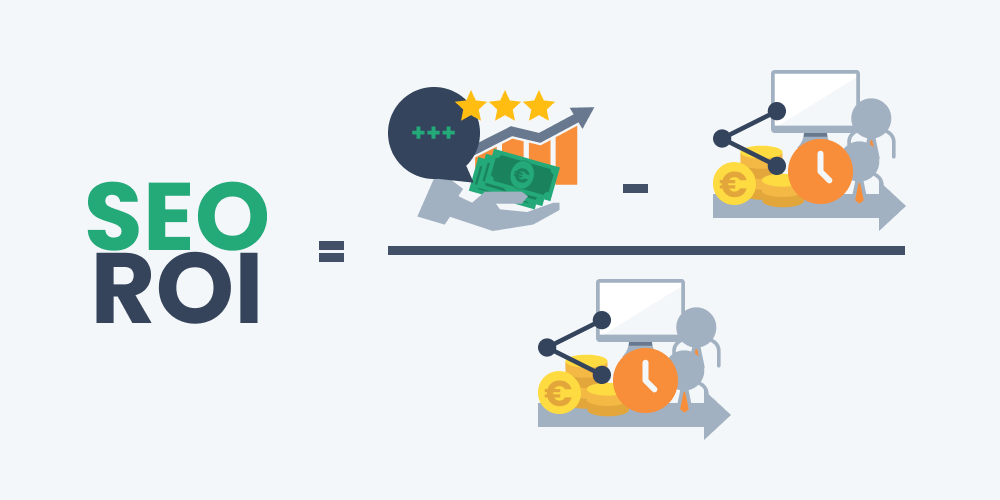ROI of SEO: Maximizing Your Investment in Search Engine Optimization
Introduction of ROI in SEO
ROI (Return on Investment) is an important metric in SEO (Search Engine Optimization) that measures the profitability of a website’s SEO efforts. The goal of SEO is to improve a website’s visibility and ranking in search engine results pages (SERPs), which can lead to increased traffic, engagement, and conversions.
To calculate the ROI of SEO, you need to compare the cost of your SEO efforts to the revenue generated from those efforts. For example, if you invest $5,000 in SEO and generate $20,000 in revenue from organic traffibc, your ROI would be 300% ($20,000/$5,000).
ROI in SEO is important because it helps you determine whether your SEO strategy is generating a positive return on investment.
To improve your SEO ROI, you can focus on optimizing your website for high-value keywords, creating high-quality content that engages and converts visitors, and implementing technical SEO best practices to improve site speed, mobile responsiveness, and user experience. You can also track and analyze your SEO metrics regularly to identify trends and opportunities for improvement.
Understanding ROI in SEO
ROI (Return on Investment) in SEO (Search Engine Optimization) is a metric that helps businesses understand the profitability of their SEO efforts. ROI is the ratio of the revenue generated from your SEO investment to the cost of your SEO investment.
In SEO, ROI can be calculated by dividing the revenue generated from organic traffic by the cost of your SEO investment. For example, if you spent $10,000 on SEO and generated $50,000 in revenue from organic traffic, your ROI would be 400% ($50,000 / $10,000).
ROI in SEO is important because it helps you determine whether your SEO efforts are generating a positive return on investment. A positive ROI means that your SEO investment is generating more revenue than the cost of your investment, which indicates that your SEO strategy is effective.
To improve your ROI in SEO, you need to focus on optimizing your website for high-value keywords, creating high-quality and engaging content, and implementing technical SEO best practices. It is also important to regularly track and analyze your SEO metrics to identify trends and opportunities for improvement.
Strategies for Maximizing SEO ROI
Maximizing SEO (Search Engine Optimization) ROI (Return on Investment) requires a combination of effective strategies that help you generate the highest possible revenue while minimizing the cost of your SEO investment. Here are some strategies for maximizing SEO ROI:
1. Conduct keyword research:
Conducting keyword research helps you identify high-value keywords that your target audience is searching for. By optimizing your website for these keywords, you can increase your chances of ranking higher in search engine results pages (SERPs) and attracting more organic traffic to your site.
2. Optimize your content:
Creating high-quality and engaging content that aligns with your target audience’s interests is crucial for SEO success.
3. Implement technical SEO best practices:
Technical SEO involves optimizing your website’s technical aspects, such as site speed, mobile responsiveness, and site architecture, to improve user experience and search engine ranking. Implementing technical SEO best practices can help you improve your website’s visibility and ranking, leading to increased organic traffic and revenue.
4. Build quality backlinks:
Building high-quality backlinks from authoritative websites can improve your website’s credibility and search engine ranking. Focus on building backlinks from high-quality websites in your industry to maximize SEO ROI.
5. Track and analyze your SEO metrics:
Regularly monitoring your SEO metrics, such as organic traffic, keyword rankings, bounce rate, and conversion rate, can help you identify trends and opportunities for improvement. Analyzing your SEO metrics can help you make informed decisions about optimizing your website to maximize SEO ROI.
The Future of SEO ROI
The future of SEO (Search Engine Optimization) ROI (Return on Investment) is likely to be shaped by several key trends and developments. Here are some potential future trends for SEO ROI:
1. The increased importance of mobile-first indexing:
As more and more people use mobile devices to access the internet, search engines are increasingly prioritizing mobile-first indexing. This means that websites that are optimized for mobile devices are likely to rank higher in search engine results pages (SERPs), leading to increased organic traffic and revenue.
2. The rise of voice search:
Voice search is becoming more prevalent, with consumers increasingly using virtual assistants such as Siri, Alexa, and Google Assistant to search for information. This presents new opportunities for businesses to optimize their content for voice search queries, leading to increased organic traffic and revenue.
3. Greater focus on user experience:
Search engines are placing greater emphasis on user experience, including factors such as page load speed, mobile responsiveness, and ease of navigation. Websites that prioritize user experience are likely to rank higher in search results, leading to increased organic traffic and revenue.
4. The growth of AI and machine learning:
As AI and machine learning continue to evolve, search engines are likely to become more sophisticated in their ability to understand user intent and deliver highly relevant search results. This presents new opportunities for businesses to optimize their content and website structure to improve search engine rankings and generate a higher ROI.
5. The increasing importance of local SEO:
As more consumers use search engines to find local businesses, local SEO is becoming increasingly important. By optimizing their website and content for local search queries, businesses can attract more organic traffic and revenue from local consumers.
Conclusion
In conclusion, SEO ROI is a critical aspect of online marketing and plays an essential role in the success of businesses. The key to achieving a positive ROI from SEO investments is to implement effective strategies that focus on improving website visibility, attracting more organic traffic, and increasing revenue. This can be achieved by optimizing website structure, creating high-quality and engaging content, building high-quality backlinks, and staying up-to-date with the latest SEO trends and developments. By maximizing the ROI of SEO, businesses can increase their online success, attract more customers, and improve their bottom line.
How to improve ROI with SEO?
To improve ROI with SEO, you can focus on optimizing your website for relevant keywords, creating high-quality and engaging content, building quality backlinks, and improving user experience. It’s also important to track your metrics, regularly analyze your data, and adjust your strategy accordingly. By continually improving and refining your SEO approach, you can increase your website’s visibility, drive more traffic, and ultimately boost your ROI.
What is a good ROI for SEO?
There is no set benchmark for ROI in SEO, as it can vary depending on factors such as the industry, target audience, and competition. However, a good ROI for SEO would typically involve achieving a significant increase in website traffic, lead generation, and revenue growth that outweighs the cost and effort invested in the SEO campaign. It’s important to set realistic goals and track your progress regularly to determine the success of your SEO strategy.
How do you measure ROI from SEO?
Measuring ROI from SEO involves tracking key performance indicators (KPIs) such as organic traffic, keyword rankings, conversion rates, and revenue generated from organic search. You can use tools like Google Analytics, SEMrush, and Ahrefs to monitor these metrics and analyze the performance of your SEO campaign. To calculate the ROI, you need to compare the revenue generated from organic search against the cost of your SEO efforts, including expenses such as content creation, link building, and SEO tools. By regularly measuring and analyzing these metrics, you can make data-driven decisions to optimize your SEO strategy and improve your ROI.
What is the average ROI of SEO marketing?
There is no set average ROI for SEO marketing, as it can vary depending on various factors such as the industry, target audience, competition, and the effectiveness of the SEO strategy. However, a successful SEO campaign can generate a significant return on investment by increasing website traffic, generating leads, and driving sales. It’s important to set realistic goals and track your metrics regularly to determine the success of your SEO marketing efforts.
How do you calculate ROI for keywords?
To calculate the ROI for a specific keyword, you need to track the revenue generated from that keyword and compare it to the cost associated with ranking for that keyword. Here are the steps to calculate the ROI for a keyword:
Determine the revenue generated from the keyword:
Track the total revenue generated from the traffic that came from the keyword over a specified period.
Calculate the cost of ranking for the keyword:
Add up the total cost of your SEO efforts for that keyword, including expenses such as content creation, link building, and SEO tools.
Calculate the ROI:
Divide the revenue generated by the cost and multiply by 100 to get the ROI percentage.
For example, if you generated $10,000 in revenue from a keyword and spent $1,000 in SEO efforts to rank for that keyword, the ROI would be (10,000-1,000)/1,000 * 100 = 900%.
How can we improve ROI?
To improve ROI, you can focus on the following strategies:
Optimize your website for conversion:
Improve your website’s user experience and optimize your landing pages to increase conversions.
Increase website traffic:
Use SEO, social media, email marketing, and paid advertising to drive more traffic to your website.
Reduce costs:
Analyze your expenses and identify areas where you can reduce costs, such as using more cost-effective tools or outsourcing certain tasks.
Improve targeting:
Refine your targeting to ensure you’re reaching the right audience and generating high-quality leads.
Optimize pricing:
Experiment with pricing to find the sweet spot that maximizes revenue while still providing value to your customers.
Continuously analyze and optimize:
Regularly track your metrics, analyze your data, and adjust your strategy to improve your ROI over time.
What is a good ROI on Google Ads?
A good ROI on Google Ads typically varies depending on factors such as industry, target audience, and competition. However, a generally accepted rule of thumb is to aim for a return on ad spend (ROAS) of at least 300%, meaning that for every $1 spent on ads, you generate $3 in revenue. However, a higher ROAS is always better, and it’s important to set realistic goals and track your metrics regularly to determine the success of your Google Ads campaigns.
Why is ROI important?
ROI (Return on Investment) is important because it measures the profitability and effectiveness of an investment. By calculating ROI, you can determine if the investment is generating enough revenue to cover its costs and whether it’s worth continuing to invest in. ROI can also help you make informed decisions about where to allocate resources and optimize your strategy to achieve better results. Overall, ROI is a critical metric for any business or organization looking to maximize profitability and make data-driven decisions.
What are Three Types of ROI?
The three types of ROI are:
Financial ROI:
This measures the profitability of an investment in terms of financial gains and losses.
Social ROI:
This measures the non-financial impact of an investment, such as its effect on social or environmental outcomes.
Marketing ROI:
This measures the return on investment of marketing campaigns, such as the revenue generated from a specific marketing channel or campaign.
Why is a high ROI good?
A high ROI (Return on Investment) is good because it indicates that the investment is generating a significant return relative to its cost. A high ROI means that the investment is profitable and effective, and it can help businesses and organizations make informed decisions about where to allocate resources and optimize their strategies. A high ROI also means that the investment is generating more revenue than its cost, which can lead to increased profitability, growth, and success in the long run.
Contact us for More Services, Which we Provide
7) Chat Service
10) Web Hosting
12) Video Designing
Contact Us
+91-9380797662
info@emazel.com
Author


